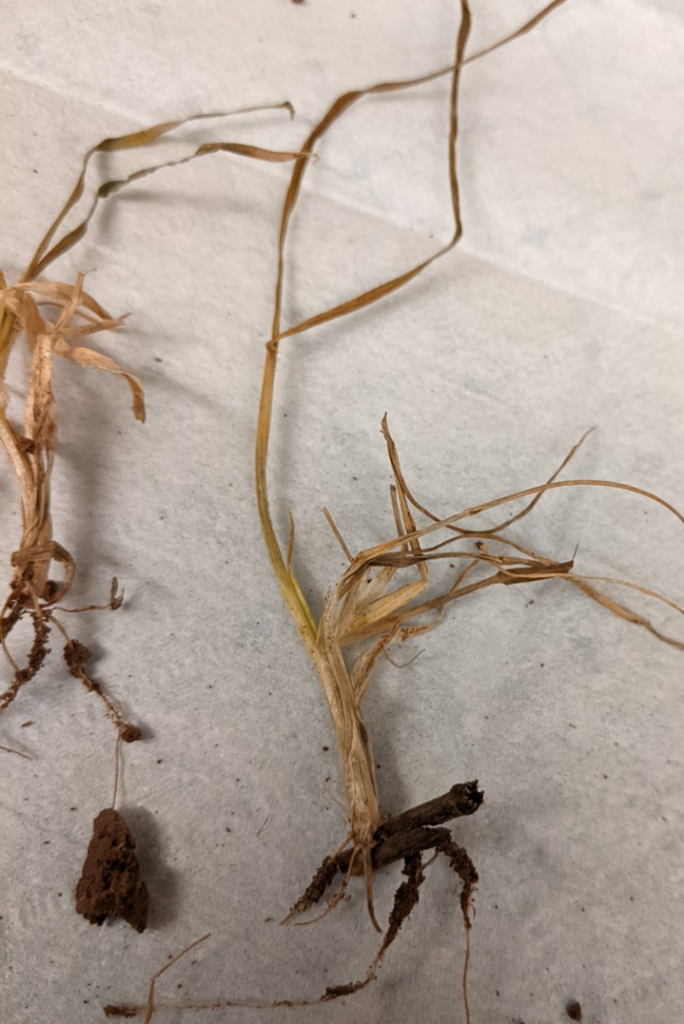Wheat Disease Update – 28 April 2022
Categories: Disease updates
Meriem Aoun, Small Grains Pathologist
Department of Entomology & Plant Pathology, Oklahoma State University
During April, the Plant Disease and Insect Diagnostic Laboratory at OSU received multiple wheat samples showing symptoms of streaking on the leaves. Leaf streaks were greenish yellow and parallel as shown in Figure 1. Enzyme linked immunosorbent assay (ELISA) on these samples from different wheat varieties were positive for wheat streak mosaic virus (WSM). WSM infected samples were from fields in multiple counties in Oklahoma including Payne, Blaine, Cimarron, Harper, Grady, and Garfield. A couple of samples that tested positive for WSM were also positive for high plains virus (HPV) and were from Harper and Blaine counties. Both WSM and HPV are transmitted by wheat curl mite. I also observed symptoms of barley yellow dwarf virus (Figure 2) in fields in Payne, Cleveland, and Grady counties.
 Figure 1. Wheat streak mosaic virus symptoms on the wheat variety ‘OK Corral’ (Grady County, April 13, 2022).
Figure 1. Wheat streak mosaic virus symptoms on the wheat variety ‘OK Corral’ (Grady County, April 13, 2022).
 Figure 2. Symptoms of barley yellow dwarf infection on the wheat variety ‘OK Corral’ in a farmer field in Cleveland County, OK (the photo was taken by Bradley Secraw, extension educator, at Cleveland County on April 26, 2022).
Figure 2. Symptoms of barley yellow dwarf infection on the wheat variety ‘OK Corral’ in a farmer field in Cleveland County, OK (the photo was taken by Bradley Secraw, extension educator, at Cleveland County on April 26, 2022).
I also observed leaf spotting on the wheat variety ‘OK Bullet’ in the Stillwater Agronomy Research Station. Culturing from the leaves resulted in the identification of the fungi Bipolaris sorokinana which causes spot blotch and Parastagonospora nodorum which causes septoria nodorum blotch. Parastagonospora nodorum was also recovered from leaf spots on leaves of the variety OK Corral in Cleveland County.
Around mid-April, the OSU Diagnostic Lab received a wheat sample from the variety ‘Doublestop’ from Blaine County. I examined the sample and I found that the infected plants were stunted and brown and showed weak root systems (Figure 3). Culturing from infected tissues identified Bipolaris sorokiniana which causes common root rot and Fusarium sp. which cause root, crown and foot rots. These fungi are favored by drought conditions in Oklahoma during the fall and spring.
 Figure 3. Common root rot and Fusarium root, crown and foot rots in a wheat sample from the wheat variety ‘Doublestop’ (Blaine County, April 13, 2022).
Figure 3. Common root rot and Fusarium root, crown and foot rots in a wheat sample from the wheat variety ‘Doublestop’ (Blaine County, April 13, 2022).